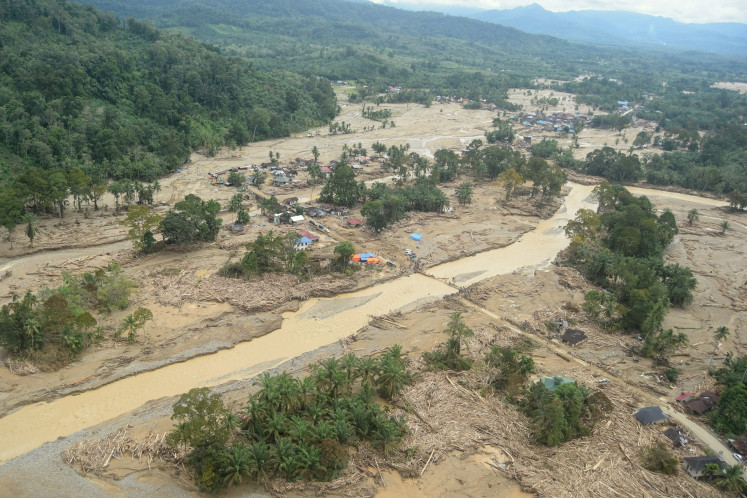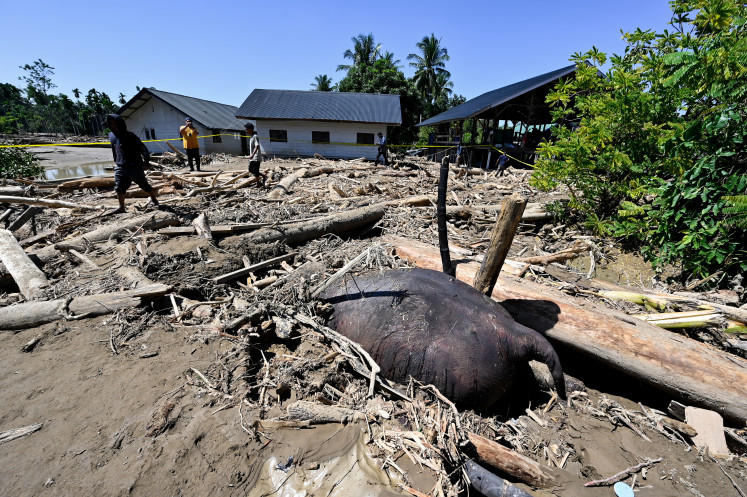Popular Reads
Top Results
Can't find what you're looking for?
View all search resultsPopular Reads
Top Results
Can't find what you're looking for?
View all search resultsIndonesia commits to rhinoceros conservation programs
Mama and her big baby: Two Sumatran rhinos, Ratu (right) and her two-month-old baby Andatu, eat vegetation at the Sumatra Rhino Sanctuary (SRS) in Way Kambas, Lampung, on Friday
Change text size
Gift Premium Articles
to Anyone
 Mama and her big baby: Two Sumatran rhinos, Ratu (right) and her two-month-old baby Andatu, eat vegetation at the Sumatra Rhino Sanctuary (SRS) in Way Kambas, Lampung, on Friday. (JP/Indra Harsaputra) (right) and her two-month-old baby Andatu, eat vegetation at the Sumatra Rhino Sanctuary (SRS) in Way Kambas, Lampung, on Friday. (JP/Indra Harsaputra)
Mama and her big baby: Two Sumatran rhinos, Ratu (right) and her two-month-old baby Andatu, eat vegetation at the Sumatra Rhino Sanctuary (SRS) in Way Kambas, Lampung, on Friday. (JP/Indra Harsaputra) (right) and her two-month-old baby Andatu, eat vegetation at the Sumatra Rhino Sanctuary (SRS) in Way Kambas, Lampung, on Friday. (JP/Indra Harsaputra)
M
span class="caption" style="width: 509px;">Mama and her big baby: Two Sumatran rhinos, Ratu (right) and her two-month-old baby Andatu, eat vegetation at the Sumatra Rhino Sanctuary (SRS) in Way Kambas, Lampung, on Friday. (JP/Indra Harsaputra)
Five Asian countries, including Indonesia, have endorsed a joint resolution to launch rhinoceros conservation and breeding programs in national parks in Java and Sumatra as part of international efforts to save critically endangered Asian rhino populations from extinction.
The joint resolution was issued by representatives from Bhutan, India, Malaysia, Nepal and Indonesia after they attended the First Asian Rhino Range State Meeting in Bandar Lampung from Wednesday to Friday.
'One of the points in the resolution regards an agreement to form a joint conservation area for three rhino species, namely the Javan rhinoceros (Rhinoceros sondaicus), Sumatran rhinoceros and Indian rhinoceros, also called the greater one-horned rhino (Rhinoceros unicornis),' Indonesia Rhinoceros Foundation (Yabi) director Widodo Ramono told The Jakarta Post on the sidelines of the event Friday.
Widodo said that the meeting's four other members urged Indonesia to stop sending Sumatran rhinos to other countries.
According to data from the Indonesian Forestry Ministry, of the three rhino species in Asia, the Javan rhinoceros is regarded as the most at risk of extinction, as only around 50 remain, all located in Ujung Kulon National Park in Banten province.
The Sumatran rhinoceros, of which fewer than 100 remain, is found in Mount Leuser National Park in Aceh and in the Way Kambas and Bukit Barisan Selatan national parks in Lampung.
Meanwhile, Indonesian delegate and director of the Indonesia Safari Park Tony Sumampauw said the agreement between the five states was a sign of progress after the World Conservation Union's Asian Rhino Specialist Group initiated a Sumatran rhinoceros breeding program in 1984.
'This indicates that Indonesia is not the only state compelled to save the Javan and Sumatran rhinos, but also other stakeholders, including other Asian countries and the global community through collaboration with Interpol in dealing with the illegal trade in rhino horns in Vietnam and China,' said Tony.
He added that in the meeting delegates had agreed to form a joint rhino protection unit, to conduct research on the spread of rhinos and to create a rhino sperm bank in Asia.
'Indonesia will further expand ex-situ semi-natural conservation in the form of a breeding program and the development of the Javan rhino study conservation area at the Ujung Kulon National Park. It will also conduct rhino protection unit activities in several national parks,' Tony said.
World Wildlife Fund for Nature (WWF) Asian Rhino and Elephant Program manager Christy Williams said the international community had paid significant attention to the plight of rhino species across Africa, but relatively little focus had been given to Asian species.
'There are far fewer rhinos remaining in Asia. As of March 2013, there were only 3,500 rhinos in Asia [compared to over 25,000 across Africa],' Christy said.
However, she said there were proven examples of rhino populations bouncing back from the edge of extinction.
'Committed action by governments has resulted in the rhino population more than doubling in the Indian state of West Bengal over the last 13 years,' Christy said.
Strong action against rhino poaching in Nepal and India have helped rhino numbers recover, she added.









